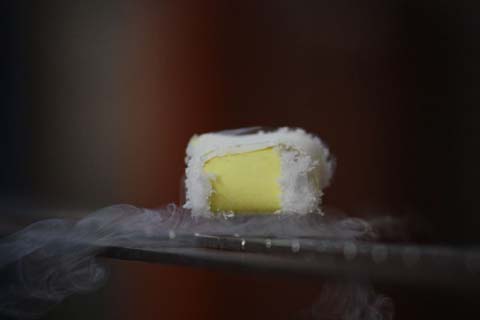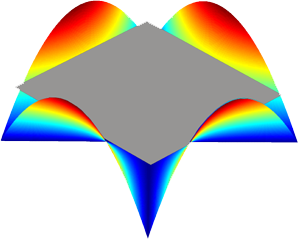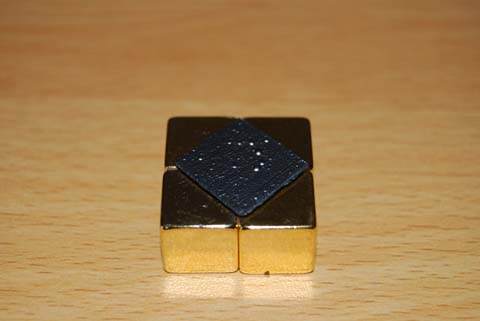Levitation
What is levitation?
Levitation is when a something rises into the air or something floats in the air without visible means of support.

Levitation piece of YBCO superconductor above a
magnetic track
Can we levitate everyday objects, or even a person?
This is an interesting question to consider
scientifically, as it's often thought to be realm of magicians
and movies!
We might have had experience as a child of playing with magnets.
But no matter how carefully we try to balance them, it seems to
be impossible to get one magnet to float above another - they
just flip over and snap together.
Diamagnetic Levitation
Despite this initial failure, using magnetism is actually the way forward! A diamagnetic material responds to oppose any external magnetic field the material is subject to.
Diamagnetism is a quantum mechanical effect arising from the change in the orbital velocity of the electrons around the nucleus of the atom in response to an applied magnetic field.
All materials show this diamagnetic response to an applied field although, because this is a weak effect, it is overpowered in those materials which also exhibit ferromagnetism or paramagnetism.
Common materials such as water, organic compounds
(such as wood, plastics), metals (copper, gold, mercury) and even
your body are all diamagnetic, but only very slightly. This ability
to repel magnetic fields gives us the possibility of being able
to levitate objects!

Graphite levitating above magnets
At room temperature, one of the best diamagnets is the metal bismuth. Slightly more diamagnetic (in one direction) is pyrolytic graphite. This grows very slowly by a process called chemical vapour deposition creating a highly ordered material where the carbon atoms form a layered hexagonal structure.
Because of the low density of pyrolytic graphite (compared with bismuth) a thin sheet will be repelled by a sufficiently strong neodymium magnet. A thick piece will be too heavy as the material above about a half of a millimetre does not contribute much to the lift.
If the piece is thin enough, it will simply slide right off the side of a single magnet, and refuse to sit still on it. To get a piece of pyrolytic graphite to sit still above a magnet, we need to find a way to force it to the centre of a magnet.

Layout of poles of magnets
This can be achieved by using a set of four magnets (creating a magnetic potential well). The pole of each of the magnets (where the field is strongest) forces the graphite to the centre. This effectively pins the graphite above the magnets. The diagram below shows the magnets coloured green and blue (with their North and South poles arranged as shown) and the pyrolytic graphite in grey in the centre.

Magnetic field strength (colours) pinning graphite
(grey) above magnets
This creates a stable room temperature levitation demonstration where the graphite is levitated about 1mm above the magnets. When pushed gently down, the graphite moves, but if the pressure is removed it levitates again.

Graphite levitating above magnets
Magnetic fields are measured in units of Tesla. The earth's magnetic field is around 0.0001 Tesla and the field from the neodymium magnets used for the graphite levitation is around 1T.
In Nijmegen in the Netherlands, there is a special scientific laboratory dedicated to performing experiments at very high magnetic fields. These are created using large coils of wire and very high currents and create fields more than 300,000 times larger (upto 33T) than the earth's magnetic field. These magnets are strong enough to levitate even weakly diamagnetic objects such as frogs, strawberries or grasshoppers!! They have a very good website, with many videos - click here.







